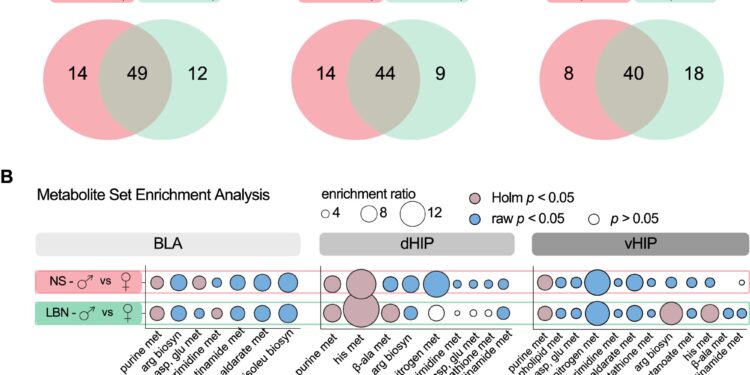Metabolomics reveals altered glutamate, pyrimidine, and purine pathways linked to sex and stress conditions. Credit: Communication biology (2024). DOI: 10.1038/s42003-024-07396-8
Early life stress (ELS) can have long-term effects on mental health, increasing the risk of developing anxiety disorders and post-traumatic stress disorder (PTSD). Importantly, women are disproportionately affected by PTSD, highlighting the need to understand how biological sex influences responses to trauma.
A study published in Communication biology revealed, using machine learning tools, striking differences in how men and women respond to stress, both in behavior and in brain metabolism and the regulation of stress hormones.
Childhood stress, such as neglect or adversity, is a known risk factor for developing mental disorders later in life. Researchers at the Max Planck Institute for Psychiatry (MPI) in Munich, led by Joeri Bordes and Mathias Schmidt, used a mouse model of ELS to study how it affects fear learning and memory in men and women. women.
They found that ELS led to increased fear responses that were different in men and women: men showed passive fear coping strategies (freezing), while women showed active fear coping strategies. fear (flight or flight behaviors). ELS affects men and women at different times, with women experiencing more acute effects and men experiencing more lasting changes. Women have high levels of the stress hormone (corticosterone) immediately after exposure to stress early in life, while men do not.
The researchers also examined metabolic processes in brain regions associated with fear and stress, including the amygdala and hippocampus. They discovered sex-specific, stress-dependent changes in brain metabolism: ELS triggered sex-specific alterations in critical metabolic pathways, processes essential for energy production, DNA repair and neuronal communication. These findings suggest that early life stress reprograms how the brain manages energy and signaling, potentially increasing vulnerability to mental disorders later in life.
Implications for mental health
“Our results highlight the importance of considering gender differences in the neurobiological pathways underlying trauma-related behaviors,” says Bordes, lead author of the study. “This knowledge could pave the way for the development of sex-specific interventions for people who have experienced early life stress.”
This research provides crucial new insights into the complex relationship between ELS, gender, and fear. By understanding these sex-specific effects, researchers hope to develop more effective treatments for trauma-related disorders. Potential therapies targeting specific metabolic pathways could be tailored to meet the different needs of men and women.
“By understanding how stress affects the brain differently in men and women, we come closer to building a world where mental health care is more effective, more equitable and tailored to individual needs,” hopes Schmidt, chief from the MPI research group.
More information:
Joeri Bordes et al, Sex-specific fear acquisition following early life stress is linked to amygdala and hippocampal purine and glutamate metabolism, Communication biology (2024). DOI: 10.1038/s42003-024-07396-8
Provided by the Max Planck Society
Quote: Early-life stress alters brain metabolism differently in male and female mice, study reveals (January 14, 2025) retrieved January 14, 2025 from
This document is subject to copyright. Except for fair use for private study or research purposes, no part may be reproduced without written permission. The content is provided for informational purposes only.



